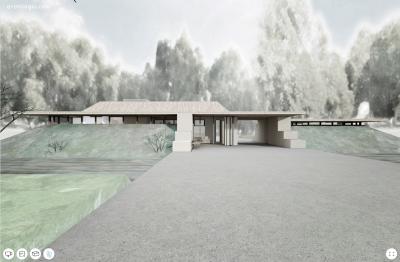
In 1941, a group of teachers, autoworkers, and other middle class professionals, which banded together in the ‘30, decided to embark on an experiment in cooperative living. Using the name Cooperative Homesteads, they purchased a 160-acre farm on land that is now part of the suburb of Madison Heights, planning to build a back-to-the-land community. As they began planning and designing their future home, the group met Taliesin apprentice Aaron Green who, seeing the similarities between the homesteaders’ idealistic vision and his boss’s Usonian structures and Broadacre City plan for decentralized country living, felt Mr. Wright would want to get involved.
Soon, Frank Lloyd Wright was designing small homes for the future residents of this worker’s utopia. By 1942, he had sketched plans for small homes built with rammed earth construction, a quirky and affordable addition to his body of work (and a new spin on the term Prairie style). Wide overhangs with large glass windows would protect the berms, which would be covered in grasses and moss, while allowing daylight into the modest cottage-sized homes. The site was to have 79 homes, each with two bedrooms and a breezeway carport, as well as a workshop and storage space for dry goods and vegetables. It was a vision of limited self-sufficiency; workers, sustained by their factory jobs, would also grow most of their own food on their own plot of land.
Go to the GEO front page

Add new comment